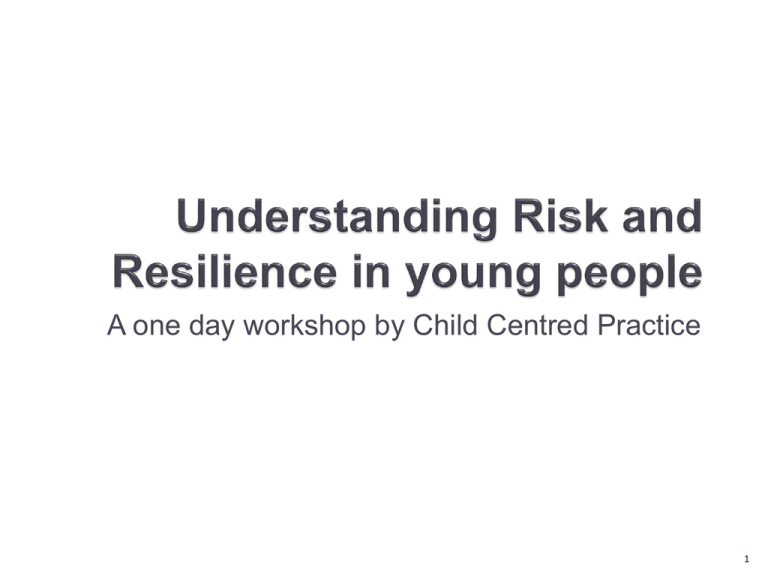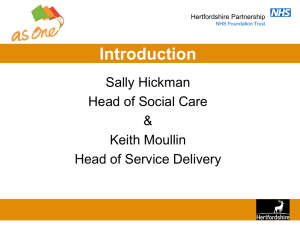
A one day workshop by Child Centred Practice
Hertfordshire County Council Changing the Culture
1
The assessment of needs?
2.
Judgement about eligibility?
3.
A calculation of the match between need and available
resources?
4.
Evaluation of risk and urgency?
In fact social workers undertake assessments for a range of
purposes and there is no consensus on what those purposes
are (Crisp et al, 2003)
1.
2
Assessment is not only multi-faceted but multilayered in ways that are not always visible in the
assessment encounters of individuals.
Individual assessments may be made on the basis of
‘professional judgement’ or a set of independent
,agency criteria, but both are carriers of judgement
and priorities formulated outside the assessment
situation.
( pg 22, Assessment in social work: A guide for learning and teaching, Whittington. C, scie,2007)
3
Developing a sound approach
Hertfordshire County Council Changing the Culture
4
people's beliefs 'are remarkably resilient in the face
of empirical challenges that seem logically
devastating' (Kahneman, 1990, p.144).
Hertfordshire County Council Changing the Culture
5
Consideration of all possible known
alternatives
Use of a maximum amount of information
Careful weighing of all information and
avoiding intuitive conclusions
A maximum degree of sound reasoning
6
In reality we all use SHORTCUTS:
Based on similarity to pass knowledge
Information
Experience
Beliefs
Help to minimise cognitive effort needed to
thoroughly assess a case
7
The Halo Bias – case work attributing too
much to general impressions of person,
situation, report
The negative information bias – tendency to
weigh negative information more heavily
than positive when making decisions
The stereotype bias – stereotypes a way of
organising information – does not tell the
whole story.
8
The confirmation bias – seek information
that supports one’s decisions or beliefs
whilst ignoring evidence that challenges the
conclusion.
The supporting evidence bias – the
tendency to be more engaged by what we
like than what we do not like. We
subconsciously decide what we want or
expect the outcomes to be before we
understand why we want it.
9
Intuitive
How people reason
Establishing rapport
Using empathy and
experience
Imagination
Unconscious appraisal of
competence.
Analytical
Formal logic
Probability theory
Decision theory
Formal instruments
Empirical research
Measure specific
dimensions
Statistics of equations
Taken from Dalzell and Sawyer, Putting Analysis into Assessment, NCB, 2007.
10
Strengths
Fundamental
Swift
Interpersonal
Draws on knowledge and
research
Tacit – even if can’t be
articulated, still valuable
Survived over time
Weakness
Implicit – defective as
knowledge not shared
Not necessarily reliable
Limited to a range of own
experience and bias
Blind spots – look for
evidence to confirm
assumptions.
Hertfordshire County Council Changing the Culture
11
Strengths
Knowledge base from
empirical research
Summaries and critics
readily available
All aspects of subject has
been studied
Need to justify actions –
public accountability
Weaknesses
Findings tentative – only weak
casual link at times
Can’t just read findings – need to
understand context, use judgement
Difficult to export to different
populations
Definitions of abuse change over
time
Cannot have random controls
Hertfordshire County Council Changing the Culture
12
Actuarial tools
Do demonstrate a higher level of accuracy and
consistency than professional judgements
Provide an opportunity for consistency across
agency and workers
Help in developing clear standards
Are not infallible
13
Hertfordshire County Council Changing the Culture
14
15%
30%
15%
Therapeutic
Technique
Client Hopefulness
Client Characteristics
& Social Support
Relationship between
client and therapist
40%
Kieran McKeowan A guide to what works in family support services for
vulnerable families (Dublin, 2000)
Hertfordshire County Council Changing the Culture
15
Hertfordshire County Council Changing the Culture
16
Critical period in lives of all young people – particularly
for young people who are looked after – dealing with
uncertainties about the future & traumas or their past.
How young people deal with all the changes adolescence
brings will be influenced by what has happened before
- experiences in infancy & childhood
- quality of attachments
- their ways of resolving problems.
- Their connections to the wider community.
Hertfordshire County Council Changing the Culture
17
Physical changes – puberty (physically girls
earlier than boys)
Development of sexual identity (can be
exciting, confusing, overwhelming)
Cultural & family expectations need to be
resolved.
If previous sexual abuse – often arises and
needs to be dealt with.
Hertfordshire County Council Changing the Culture
18
Preparation for financial independence – taking more
responsibility for this.
Increased domestic responsibility – often a source of
tension in the home.
Separation from family of origin – can happen at various
stages for various reasons L.A.C – no choice usually
when younger, will affect things when adolescent.
Hertfordshire County Council Changing the Culture
19
Development of moral code. Draw on and are powerfully
influenced by beliefs & behaviours of their family &
communities.
Often go through periods of questioning, trying out
different ideas.
Negotiating peer relationships – can be a difficult task
– major challenge (esp if child has poor self
esteem/poor social skills)
Hertfordshire County Council Changing the Culture
20
Peer group pressures – can
be very powerful.
Finding & sustaining
intimate relationships
outside the family of origin
– adolescence- growing up
leaving behind childhood
dependency – balancing
needs for closeness &
autonomy.
Hertfordshire County Council Changing the Culture
21
Often thought of as a period of turmoil & uncertainty
but can be exciting & challenging.
Can be a period where the prevalence of problems &
disorders rises – e.g: rates of depression.
What is ‘normal’ adolescence? – difficult at times to
distinguish between ordinary transitional development &
mental disorder.
Hertfordshire County Council Changing the Culture
22
‘Normal’ –powerfully influenced by our values &
beliefs.
Children who are looked after also have the
beliefs & opinions of carers, social workers &
other professionals plus policies of agencies
involved in aspects of their lives.
Hertfordshire County Council Changing the Culture
23
Hertfordshire County Council Changing the Culture
24
A self harming young person who seems out of
control can be very distressing for the
professionals surrounding them.
This is not the time to opt out.
Sometimes we work with young people one hour
at a time and hope.
Hertfordshire County Council Changing the Culture
25
Playing a bad hand well, rather than
getting a good hand
Hertfordshire County Council Changing the Culture
26
Sufficient income support and good physical standards
in the home.
Practical and domestic help.
Regular medical and dental checks including school
medicals.
Factual information about puberty, sex and
contraception.
Regular attendance at school.
Sympathetic, empathic and vigilant teachers.
Hertfordshire County Council Changing the Culture
27
Belonging to organised, out of school activities, including homework
clubs.
A mentor or trusted adult with whom the child is able to discuss
sensitive issues.
An adult who assumes the role of champion and is committed to the
child and 'acts vigorously, persistently and painstakingly on their
behalf' (Department of Health 1996, p.24).
Hertfordshire County Council Changing the Culture
28
-clubs and hobbies
-summer camps
-belonging to something good (families, peer groups
etc.)
- -doing good, volunteering etc.
-being paid
-holistic interventions that don’t just tackle ‘the issues’
or ‘one issue’
-having mentors who stick with disadvantaged kids
over time (challenge to ‘projects’ and specialisation)
-Using the mass media (celebs)
- exploiting the full potential of the internet, mobile
phones and other new technologies (Youth matters)
Hertfordshire County Council Changing the Culture
29
To achieve their maximum potential kids will
be protected by having all the things we know
they need:
good education
love and sense of belonging
decent standard of living
great parenting
intelligence
good looks
opportunities to contribute
Hertfordshire County Council Changing the Culture
30
Some kids do better than others having had very similar experiences
– we can be the factor that makes a massive difference
Complexity theory: small changes, big effects; and we can’t always
see the protective effects immediately –daring to do things
differently, being open minded, confident
There is hope for everybody! Resilience theory helps us to work
relentlessly towards better outcomes– helps us keep enthusiastic
and focused
Resilience theory gives us a framework within which to plan positive
chain reactions with and for individual children (and for yourselves),
and to reduce negative ones
For young people doing risky things it is still really helpful to get
some protective processes going
Hertfordshire County Council Changing the Culture
31
Hertfordshire County Council Changing the Culture
32
An adolescent needs adults who care for them
to support them & contain them.
Challenging, worrying or extreme behaviour
makes us feel anxious which can stop us
thinking clearly about how to deal with the
situation.
Hertfordshire County Council Changing the Culture
33
Session Three
Hertfordshire County Council Changing the Culture
34
Risk can be defined as ‘the possibility of beneficial
and harmful outcomes, and the likelihood of their
occurrence in a stated timescale’
(Alberg et al, in Titterton, 2005)
Hertfordshire County Council Changing the Culture
35
Risk assessments can have a number of different
purposes.
Frameworks for assessment of children, young
people and families address service user
vulnerability and avoidance of significant harm.
Most models of risk assessment recognise that it
is not possible to eliminate risk, despite the
pressure on public authorities to adopt defensive
risk management (Power, 2004)
Hertfordshire County Council Changing the Culture
36
Focus on the negative distorts reality and can lead to a
skewed picture.
There is a duty to maximise well being as well as minimise
risk
Identifying and quantifying risk is a small part of the social
work task.
The larger part of the task concentrates on managing the
risk and developing strategies to intervene to reduce those
risks.
Hertfordshire County Council Changing the Culture
37
The concept of risk asks the social worker to predict with a
degree of accuracy the likelihood of something negative
occurring to a child in the future.
Without the use of actuarial tools social workers can be
reduced to a kind of ‘fortune telling’ approach which relies
on a combination of practice wisdom and past behaviour of
the parents to predict future home.
Hertfordshire County Council Changing the Culture
38
A risk factor for abuse is a feature found more commonly in
abusive families than in the general population.
It is not about how often it occurs but how much more often
it occurs when you compare it to the frequency within the
non abusing population.
It is rare in child abuse to get an absolute indicator – you
see them much more often in medicine (for example the
presence of this gene is a predictor of this disease. No-one
who does not have this illness has the gene).
Hertfordshire County Council Changing the Culture
39
Data taken from Brandon et al, Analysing Child deaths and serious injury through abuse and
neglect: what can we learn? 2003-2005
A history of rejection and loss (often including the death
of a parent) and usually severe maltreatment (physical,
sexual, and neglect often in combination) over long
periods of time
A history of long term intensive involvement from
multiple agencies e.g. from children’s social care
CAMHS and YOT
Hertfordshire County Council Changing the Culture
40
Parents or carers with their own history of abuse
and rejection, most of whom misused substances
and had mental health difficulties
It was difficult to contain these young people in
school. Challenging and threatening behaviours to
staff and fellow students resulted in temporary or
permanent exclusions from school
By adolescence, if not earlier, these young people
were typically harming themselves and mis-using
substances
Hertfordshire County Council Changing the Culture
41
A pattern of self-neglect could accompany the self
harm and this might include an ability to manage
chronic illness or other serious health problems
and a habit of presenting to accident and
emergency for emergency treatment or to seek
nurture
Numerous placement breakdowns
Running away and going missing
Increased risk of sexual exploitation and risky
sexual activity
Hertfordshire County Council Changing the Culture
42
Risk management means maximising
potential benefits.
These benefits should form part of any
intervention
Hertfordshire County Council Changing the Culture
43
A pro social peer group
A supportive school environment
Good problem solving skills
An adult willing to take responsibility for decision
making
Responding in a sustained way to the young
people’s extreme distress which often manifests
itself in their very risk behaviour
Hertfordshire County Council Changing the Culture
44
Brief solution focused therapy – dealing with the issues day by day
whilst trying to find ways to move them into a hopeful state for the
future.
Motivational interviewing – a technique of challenging and
increasing discomfort with current situation to a level where change
talk becomes possible
Cognitive behaviour therapy – challenging self defeating thoughts
and replacing them with a dialogue that allows for positive self talk
Scaling and tracking – demonstrating change through documenting
progress in a small scale and developing patterns of success
Hertfordshire County Council Changing the Culture
45
Important concepts with different
emphasis along the continuum of the
assessment process.
Hertfordshire County Council Changing the Culture
46
One of the great conundrums of child protection =
How to recognise the occasional families that
cannot be assisted or coerced to provide
increased safety, without demonising excessive
numbers of other families with the same, though
inappropriate label.
(pg: 45, Dazell & Sawyer, OpCit)
Hertfordshire County Council Changing the Culture
47
A child/young person can be considered to be safe when
there is no threat of danger to a child within the
family/home or when the protective capacities within the
home can manage the threats of danger.
A child/young person is Unsafe when there is a threat of
danger to a child within a family/home and the protective
capacities within the home are insufficient to manage the
threat of danger thus requiring outside intervention.
Hertfordshire County Council Changing the Culture
48
A specific family situation or behavior, emotion,
motive, perception or capacity of a family member
that is out-of-control, imminent and likely to have
severe effects on a vulnerable child
Hertfordshire County Council Changing the Culture
49
8.
Violent Caregivers or Others in the Household
Caregiver Makes Child Inaccessible
Caregiver Lack of Self Control
Caregiver Has Distorted Perception of a Child
Caregiver Fails to Supervise/Protect
Caregiver Threatened/Caused Serious Physical Harm to a Child
Caregiver Will Not/Cannot Explain a Child's Injuries
Child Provokes Maltreatment
Fearful Child
9.
Caregiver Is Unwilling/Unable to Meet Immediate Needs of Child
1.
2.
3.
4.
5.
6.
7.
Hertfordshire County Council Changing the Culture
50
1.
2.
Certain recurrent signs taken together can
provide an early warning:
History of unstable, damaging or violent adult
relationships (including violence outside the
family)
Violence to children in the form of corporal
punishment
Hertfordshire County Council Changing the Culture
51
3. Violence to children in, or no longer part of, the
family.
4. Changes in a child’s behaviour. This may not
appear to be directly related to abuse which is
occurring
5. Warning from neighbours or extended family
6. Help seeking behaviour from parents. The
message may be disguised.
Hertfordshire County Council Changing the Culture
52
7. Statements from children
8. Recurrent injuries and recurrent biographical
patterns
10. Resistance to professional intervention
11. Plausible lies and deception by parents/carers
12. Non-access to children including absence from
nursery, disappearance of families
Hertfordshire County Council Changing the Culture
53
13. Violence & threats, to self and others
14. Subverting child protection plans
15. Family pressure on children & adults not to disclose
information
16. Delay in seeking medical help
This is not intended to be an exhaustive list and nor is the
presence of any one indicator alone a sign of abuse.
However, they must be given weight in the assessment
process.
Hertfordshire County Council Changing the Culture
54
Static risk factors do not change and are
often seen as more reliable indicators for
future risk
Dynamic risk factors are both variable and
often outwith the control of the individual
It is the interplay of the static and dynamic
risk factors that are most likely to bring an
accurate understanding of the picture.
Hertfordshire County Council Changing the Culture
55
Using the assessment record to
manage interventions
Hertfordshire County Council Changing the Culture
56
‘We have remarked on the way in which (the social worker)
came up with new and often significant information which
cannot be found in her file notes. We think this matters.
Procedurally it meant that if anybody had to deputise for her
they would be under informed about things which turned out
to be important. Substantially it meant that she maintained a
personal hold on the case, because she had it within her
power to use or withhold information… it helped her skew the
case conference appraisals’
(Tyra Henry, 4.30 A study of Inquiry reports 1980 -9,
Dept of Health)
Hertfordshire County Council Changing the Culture
57
Is not a substitute for clarity of purpose
Is not a substitute for high practice standards
Is not a substitute for face to face communication
Is not an add on to the ‘day job’
Is not filling in a form
Hertfordshire County Council Changing the Culture
58
The legacy to leave the young person
Part of formal accountability
A basis for action by deputies
A way of guarding against isolated and biased
work
Hertfordshire County Council Changing the Culture
59
Detailed but not irrelevant
Accurate and include dates, times and information
sources
Available and easy to access
Hertfordshire County Council Changing the Culture
60
Using knowledge critically from research and practice
Systematic recording and updating of information,
distinguishing sources such as observation, records of
other agencies and information from family members
Evaluating continuously the effectiveness of intervention
and modifying action accordingly
Evaluating interventions to develop practice wisdom
(Whittington, C, op.cit, 2007)
Hertfordshire County Council Changing the Culture
61
Immediate
Vivid verbal account makes an impact
Making it obvious – again and again
Sitting comfortably with ambiguity
Supporting the written word – easy access
Hertfordshire County Council Changing the Culture
62
Presenting concerns coherently and in a
focused manner
Making the links between evidence and
opinion explicit
Re-enforce visually –anchor points to return
too
Supporting the spoken word – easy to access
written words
Hertfordshire County Council Changing the Culture
63
In order to have a better chance of
understanding how difficulties interact,
practitioners must be encouraged to be
curious, and to think critically and
systematically (Brandon,et al, 2008,p98)
Hertfordshire County Council Changing the Culture
64









